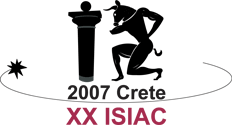 |
The following hotels constitute the official
conference hotels at preferential rates for XX
ISIAC participants. They can only be booked at
these rates by filling and submitting the official
Registration and Hotel Reservation Form.
Conference Venue Hotel
Iberostar
MIRABELLO Beach Hotel (4/5 star) - An elegant complex with suites & bungalows
situated on the beach, surrounded by gardens, pools, the Bay of Mirabello &
mountain views, 2km from the center of the city of Agios Nikolaos and 45 minutes
from Heraklion international airport. The talks and poster sessions will be held here.
Associated conference
hotels
ORMOS
(3 star) and CRYSTAL
(2 star) Hotels - within 300 meters from the
venue hotel overlooking a quiet boat marina. Nothing
luxurious, simple, clean and quiet - primarily
for students.
Heraklion
Crete
Climate
Crete -- The power of Poseidon still pounds the shores
of Crete, a land one 17th century English traveler called "the
garden of the universe." Crete is where gods were born, where
myths flourished, and where Europe's earliest civilization --
the Minoans -- rose from the Mediterranean.
According to Greek mythology, Crete was the birthplace of Zeus,
chief of the gods. And it was here that a half-man, half-bull
-- the Minotaur -- devoured young men and women in the Labyrinth,
until it was killed by the warrior Theseus.
The roots of these legends lie shrouded in historical mystery.
But ruins of entire cities leave little doubt that an advanced
people once ruled here, centuries before the Greeks and Romans.
On the surface, Crete may seem typically Greek. But a deeper
dig reveals that Crete's culture is unique. The island became
part of Greece in 1913 -- before that, Romans, Byzantines, Venetians
and Turks had been its rulers.
Crete is the largest of the Greek islands, stretching more than
150 miles (242 kilometers) east to west. A short trip inland
seems to contradict the fact that it's an island. Mountains
reaching as high as 8,000 feet (2,438 meters) partition Crete
into distinct regions, each with its own local flavor.
Iraklion is Crete's largest city, and feels like it. The congested
streets and busy port are a sharp contrast to quiet towns nearby.
(Source: CNN)
Heraklion -- Built on the north coast of the island, Heraklion, with a
population of 250,000
inhabitants, is the largest city in Crete and ranks fourth in the whole of the country.
Its old walls, the most important monument surviving from the Venetian era, depict the city's adventurous past.
History connects the place with antiquity and...Europe. It was in Crete
that , according to Greek Mythology, Zeus - the father of Gods - brought the beautiful young lady called
Europa with whom he had fallen in love. Their romance gave birth to a son, Minos, whose name was
carried by all subsequent kings of Crete.
Visitors to Heraklion almost invariably visit the
Minoan antiquities. The Archaeological Museum of Heraklion exhibits findings from the Neolithic
period (5000 BC) to the Roman period (4th century AD) and it is unique in the world
for the variety of its exhibits.
On the outskirts of Heraklion (5km from the city centre) lie the reconstructed remains of the
Knossos Palaces.
For those who love literature, Heraklion is connected with the name of Nikos
Kazantzakis, one of the most famous Greek writers
of the 20th century. He was born and raised in
this town where he lived for several years. He
is buried at the promontory of the Venetian walls,
not far from the centre of the city.
An interesting place to visit the museum dedicated to him at his ancestral village of Myrtia (15km
from Heraklion).
Contemporary Heraklion is a cosmopolitan city, the third
port of the country and one of the major Mediterranean harbours. Its ideal location (at the crossroad of
East and West) and its mild climate, made the city - as well as the whole island - a
major tourist centre. The city hosts cultural activities with a local, European and
International dimension and appeal: art exhibitions, theatre performances, cultural
events, international conferences, scientific meetings, etc.
Climate -- The weather in Crete is generally warmer than the rest of
Greece in winter and cooler in the summer.
During the time of the conference the weather is warm (about 30 C or 86 F), dry (about 40-60 %) and possibly windy. Chances of precipitation almost zero.
Forget your umbrella, but do bring a hat and sunscreen.
More details can be found at the following links:
Weather in Crete and Current
weather in Agios Nikolaos
|
![]()

![]()

![]()
